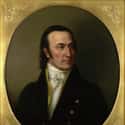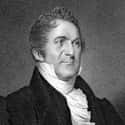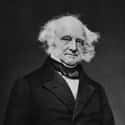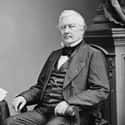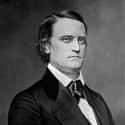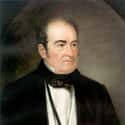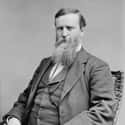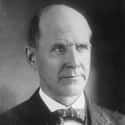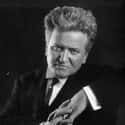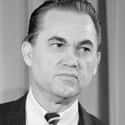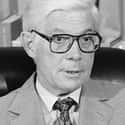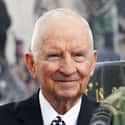-
(#1) John Floyd
- Dec. at 54 (1783-1837)
Election Year: 1832
Party Affiliation: Nullifier Party
Percentage of Vote Won: N/A
The political make-up of the United States in 1832 was far different than it is today. The party system was still evolving, and the major factions of the time were the Democrats and the National Republicans (not to be confused with today's Republican Party). The Democrats' standard-bearer was Andrew Jackson, then the sitting president. President Jackson was a hard-liner whose aggressive political style caused a fracture in the process. Numerous opponents lined up to oppose Jackson's controversial policies, which included bringing an end to the national banking system. His primary opponent, Henry Clay, represented the National Republicans, but other parties sprung up to try to stop Jackson's reelection.
The Nullifier Party was founded in South Carolina as a bastion of states' rights and the idea of nullification - which argues that states should have the power to disregard and invalidate any federal law they don't like. The party chose Virginia Governor John Floyd as its nominee. Jackson's immense popularity with the American voting population led him to a landslide reelection. Floyd, on the other hand, fared poorly. He received no percentage of the popular vote, but was awarded 11 electoral votes, as South Carolina's presidential electors were, at the time, decided by a vote of their state legislature.
-
(#2) William Wirt
- Dec. at 62 (1772-1834)
Election Year: 1832
Party Affiliation: Anti-Masonic Party
Percentage of Vote Won: 7.78%
Like John Floyd, William Wirt attempted to unseat Andrew Jackson in 1832. Wirt represented the Anti-Masonic Party, which, as the name states, was a political group dedicated to crusading against the fraternal organization known as the Freemasons. It was the belief of the Anti-Masonic Party that the Freemasons were part of a vast global conspiracy. The Anti-Masons were an early iteration of the American populist movement - highly skeptical of the elites, and against modernity and the exclusivity inherent in the Masonic organization.
Wirt took Virginia, defeating that state's sitting governor, John Floyd. Elsewhere in the country, he struggled, and this iteration of the Anti-Masonic Party dissolved eight years later.
-
(#3) Martin Van Buren
- Dec. at 80 (1782-1862)
Election Year: 1848
Party Affiliation: Free Soil Party
Percentage of Vote Won: 10%
The case of Martin Van Buren and the Free Soil Party is a unique one in American history, primarily because Van Buren had already served a single, four-year term as president from 1837-1841. The seasoned New York politician swept into office thanks to an endorsement from highly popular outgoing president Andrew Jackson, under whom he had served as vice president.
Four years later, Van Buren was defeated in his reelection bid by William Henry Harrison, but he didn't fade from the national stage as later one-term presidents like Jimmy Carter or George H.W. Bush would in the 20th century. Van Buren became a vocal abolitionist, advocating for the human rights of enslaved Americans. Free Soilers believed it was impossible for the federal government to free the slaves of the South, but that they could prevent slavery from spreading to new territories in the West.
Van Buren stood as their first presidential candidate, but found far less success in his third attempt at the presidency. The Free Soil ticket finished last out of three candidates, with Zachary Taylor of the Whig Party securing the necessary electoral votes to win the Oval Office. The Free Soil Party folded in 1854, and much of its platform was co-opted by the fledgling Republican Party.
-
(#4) Millard Fillmore
- Dec. at 74 (1800-1874)
Election Year: 1856
Party Affiliation: American Party
Percentage of Vote Won: 21.5%
Another former president seeking to return to power, Fillmore stood for the American Party, better known as the "Know Nothings," named after their cagey responses to non-party members asking for details of their organization. The previously dominant Whig Party had collapsed, the fight over slavery was reaching a fever pitch, and sitting Democratic president Franklin Pierce was so unpopular that he failed to win the nomination of his own party. This instability was an ideal breeding ground for a fringe third party to grab the national spotlight.
Echoes of the Know Nothings' party platform can be seen in today's politics: distrust of immigrants, the deportation of "undesirables," state-mandated religious education, strong government regulation of private industry, and the expansion of rights for minorities and women. The Know Nothings, while ostensibly anti-slavery, focused most of their attention on the hatred of immigrants and Catholics, making them one of the first isolationist movements in American politics. Fillmore won a significant percentage of the popular vote, but only captured one state, Maryland, netting him a scant eight electors. This would be the final presidential election to feature a Know Nothing candidate, as the Civil War made questions of immigration far less pressing.
-
(#5) John C. Breckinridge
- Dec. at 54 (1821-1875)
Election Year: 1860
Party Affiliation: Constitutional Democratic Party
Percentage of Vote Won: 18.2%
The election of 1860 proved to be a pivotal moment in American history and a major step toward the open conflict between North and South. Befitting the fractured nature of the national psyche, the 1860 election ended up being highly chaotic. The Republicans offered up former congressman and anti-slavery activist Abraham Lincoln, while the Democrats chose his long-time rival Stephen Douglas, who had bested Lincoln in an 1858 contest for one of Illinois' Senate seats.
Douglas's nomination angered the faction of Southern Democrats, who controlled much of the party apparatus, due to Douglas's support for popular sovereignty - the right of every state to decide the question of slavery for itself. The South opposed this idea and believed enslavement should be deemed legal throughout the nation, a rebuke to the idea of states' rights. The Southern Democrats splintered off, held their own nominating convention, and tapped John C. Breckinridge, sitting president James Buchanan's vice president. Breckinridge swept the South and carried 11 states, including the seven that would form the basis of the Confederate States of America. With the South seceding from the Union, the Southern Democratic insurgency ceased to be.
-
(#6) John Bell
- Dec. at 73 (1796-1869)
Election Year: 1860
Party Affiliation: Constitutional Union Party
Percentage of Vote Won: 12.6%
John Bell served as the first and only presidential candidate for the Constitutional Union Party, a coalition of former Whig and Democratic Party members who sought to heal the schism between North and South. Members of this party were dissatisfied with both the Republicans and Democrats, who carved out intractable positions on slavery.
Former Speaker of the House and Secretary of War John Bell served as the party's candidate in 1860, with the explicit aim of preventing either party from collecting enough electoral votes to win the presidency. In that event, the question of who would serve as the next president would fall to a vote of the House of Representatives. Despite collecting one of the lowest percentages of the popular vote ever for a victorious presidential candidate, Abraham Lincoln won, which some would say was due to the splitting of the vote caused by Bell and Breckinridge.
-
(#7) James B. Weaver
- Dec. at 79 (1833-1912)
Election Year: 1892
Party Affiliation: Populist Party
Percentage of Vote Won: 8.5%
The Populist Party, also known as the People's Party, was another expression of America's long history of anti-authority, anti-elitist feelings. The Populists were made up of a coalition of farmers fighting against what they believed to be restrictive government initiatives. They pushed for tariff reform, a graduated income tax, the federal regulation of railroads, and other policies designed to stop the spread of corporate influence through American economic policy.
Former Iowa congressman James B. Weaver was their nominee in 1892, collecting 22 electoral votes - the first third-party candidate to win electors since the Civil War. The Populists dissolved in 1909, but saw one major part of their platform enacted: the direct popular election of senators instead of election by a vote of state legislatures. This one reform changed American history forever.
-
(#8) Theodore Roosevelt
- Dec. at 61 (1858-1919)
Election Year: 1912
Party Affiliation: Progressive Party
Percentage of Vote Won: 27.39%
Teddy Roosevelt could be considered one of the best third-party presidential candidates, as he had already served successfully as the 26th president of the United States. Roosevelt refused to serve a third term in office and anointed William Howard Taft as his successor. But by 1912, Taft and Roosevelt had parted ways ideologically, with Taft supporting business interests and Roosevelt backing policies that favored labor unions. That led Roosevelt to break his promise and stand for election again.
Roosevelt failed to defeat Taft in the primaries, and walked away from the party in disgust. He formed the Progressive Party (more popularly known as the Bull Moose Party) and became its first presidential nominee. Owing to his popularity within the Republican Party, Roosevelt siphoned numerous votes from Taft, dooming his reelection bid. Roosevelt finished second in 1912, losing in an electoral landslide to Democrat Woodrow Wilson by a vote of 435-88.
-
(#9) Eugene V. Debs
- Dec. at 71 (1855-1926)
Election Year: 1912
Party Affiliation: Socialist Party
Percentage of Vote Won: 5.99%
Eugene Debs was, in a sense, the Bernie Sanders of his time. Debs was the standard-bearer for socialism in America for decades, running five long-shot presidential campaigns via the Socialist Party (including one run undertaken from prison after being incarcerated for speaking out against WWI).
Debs had his best showing amidst the chaos of 1912, though he carried no states. His support for labor movements and workers' rights, combined with his passionate oratory, made him the most popular socialist figure in American politics. Thanks to his efforts, the Socialist Party survived until 1972, as the polarization of US politics made niche parties less viable and socialism temporarily fell out of favor.
-
(#10) Robert M. La Follette, Sr.
- Dec. at 70 (1855-1925)
Election Year: 1924
Party Affiliation: Progressive Party
Percentage of Vote Won: 16.6%
Robert La Follette Sr. had previously attempted to win the Republican nomination in 1912, but was thwarted by Teddy Roosevelt's entry into the race. When Roosevelt decided to form his Progressive "Bull Moose" Party, La Follette declined to join him. Instead, La Follette formed his own Progressive Party in the wake of the collapse of the Bull Moose movement.
This center-left party coalesced around government regulation of business, populist political reforms, and an isolationist foreign policy. La Follette was thumped by the sitting president, conservative Republican Calvin Coolidge, who enjoyed wide popular support thanks to a booming, pre-Great Depression economy. Conservative economic policy won the day until the election of Franklin Roosevelt and his New Deal platform.
-
(#11) Strom Thurmond
- Dec. at 101 (1902-2003)
Election Year: 1948
Party Affiliation: States' Rights Democratic Party
Percentage of Vote Won: 2.4%
From the Great Depression through WWII, national politics in the United States was dominated by left-leaning FDR Democrats who were able to leverage patriotic feelings and a hunger for post-Depression social safety nets into repeated electoral success. Roosevelt's passing and the end of WWII once again threw American politics into disarray, as various forces sought to fill the power vacuum. Vice President Harry S. Truman ascended to the presidency during Roosevelt's final term, but proved to be an unpopular figure. After choosing to deploy the atomic bomb against Japan, Truman was able to take credit for the end of WWII, but he struggled with the aftermath and failed to calm the new post-war economy's labor conflict.
Truman also advocated for civil rights for African Americans, enraging the Southern Democrats who sought to continue severe segregation policies. Those who challenged Truman's platform splintered off to form the States' Rights Democratic Party, which nominated South Carolina Governor Strom Thurmond. Thanks to Thurmond's popularity among segregationists, he was able to win four states: Louisiana, Mississippi, Alabama, and his home state of South Carolina. Thurmond also won a single faithless elector in Tennessee. The elector, who was pledged to victorious President Truman, rebelled and cast his ballot for Thurmond instead. Truman narrowly won in 1948, despite the Dixiecrat rebellion and poor showings in pre-election polls.
-
(#12) George Wallace
- Dec. at 79 (1919-1998)
Election Year: 1968
Party Affiliation: American Independent Party
Percentage of Vote Won: 13.5%
Once again, political chaos led to a powerful third-party effort, and as in 1948, that challenge to the establishment came from a Southern segregationist. This time, it was Alabama Governor George Wallace, who opposed President Lyndon Johnson's attempts to integrate his state's schools. Due to Johnson's struggles to manage the conflict in Vietnam, Johnson decided not to seek another term in office, throwing the entire election cycle into disarray. Further instability was caused by the assassination of Democratic front-runner Robert F. Kennedy.
Though Johnson was off the ticket, his policies of fighting poverty and extending civil rights to African-American citizens remained part of eventual nominee Hubert Humphrey's platform. Again, this angered Southern Democrats, who loathed the idea of continuing on with Johnson's legacy. The American Independent Party was formed to support Wallace's run for the White House, and has survived to this day, though in greatly diminished form. Much of Wallace's appeal dissipated as the Republican Party scooped up frustrated segregationist Southern voters by embracing the anti-elitist, anti-intellectual rhetoric espoused by eventual 1968 victor Richard M. Nixon.
-
(#13) John B. Anderson
- 97
Election Year: 1980
Party Affiliation: N/A
Percentage of Vote Won: 6%
The 1980 election proved to be a decisive victory for Ronald Reagan and the Republican Party, but it was not without its hiccups. President Jimmy Carter had proven to be a highly unpopular chief executive thanks to the Iran hostage crisis, a sputtering economy, and high gas prices, and had to weather a primary challenge from Senator Ted Kennedy. On the Republican side, former California Governor Ronald Reagan competed against a wide variety of opponents, which included George H.W. Bush, Bob Dole, and Illinois congressman John Anderson.
Anderson fell to Reagan, but chose to mount a quixotic independent run in the general election. Anderson hoped to be a more moderate alternative to Reagan's conservative message of supply-side economics, increased military spending, and cutbacks on social programs. Anderson took no states in the face of Reagan's historic landslide victory.
-
(#14) Ross Perot
- 88
Election Year: 1992, 1996
Party Affiliation: N/A, Reform Party
Percentage of Vote Won: 18.9%, 8.4%
By the 1990s, the idea of a viable third-party presidential run seemed preposterous. The Democrats and Republicans had successfully carved out their places on the political spectrum, using money and influence to dominate national elections. Perot made billions of dollars from his data processing firm, which was bought by General Motors in 1984. Buoyed by those riches, he executed a savvy media strategy that involved carpeting the country's television and radio airways with commercials touting his populist ideas: a balanced budget with tax increases on the wealthy and severe federal budget cuts, a repeal of the North American Free Trade Agreement, and an increase in the capital gains tax. Perot was able to buy up time on TV thanks to local television's reliance on paid programming and infomercials during the '90s. Perot largely sidestepped the divisive cultural politics that would come to dominate American discourse, something that seems impossible to do today.
Perot won no electoral votes, but his strong showing in the 1992 popular vote led him to try again four years later, as the standard-bearer of the nascent Reform Party. In 1996, Perot won less than half of the votes he received in 1992, but it was enough to keep the Reform Party going into 2000. With Perot off the political stage in 2000, the Reform Party nomination was up for grabs and numerous high-profile candidates considered filling the void: Minnesota Governor Jesse Ventura, former Republican Pat Buchanan, and a New York real estate magnate by the name of Donald Trump. After a splashy, TV-friendly start to his candidacy (Trump went on CNN and said he'd pick Oprah as his running mate), Trump chose to drop out, stating that the Reform Party "now includes a Klansman, Mr. [David] Duke, a neo-Nazi, Mr. [Pat] Buchanan, and a communist, Ms. [Lenora] Fulani. This is not company I wish to keep.'' At the time, Trump espoused many socially liberal policies, including the right of LGBTQ+ citizens to serve in the military.
What Trump was expressing was an ideological incoherence in the Reform Party, which was built for Perot and could not survive without him. If the Reform Party could welcome people of such diametrically opposed viewpoints, what did it even stand for? Buchanan won the Reform nomination in 2000 and the party slowly faded into irrelevance as the Republicans' Tea Party movement became the dominant insurgency in American politics.
New Random Displays Display All By Ranking
About This Tool
In presidential elections, although third-party candidates always end in failure, the third-party candidates running for election does not make any sense if only success and failure are considered. From the perspective of political development, the participation of third-party presidential candidates is still very meaningful. First, although Republicans and Democrats monopolize most of the public offices of the US Federal Congress and state governments, sometimes third-party candidates still have individual successful political figures in presidential elections or governor elections.
The random tool lists 14 of the most viable third-party presidential candidates in history who were also influential in the United States, their contributions can not be ignored.
Our data comes from Ranker, If you want to participate in the ranking of items displayed on this page, please click here.











